A Project of the Hudson River Estuary Program
Compiled by Tom Lake, Consulting Naturalist
While enjoying outdoor spaces, please continue to follow the CDC/NYSDOH guidelines for preventing the spread of colds, flu, and COVID-19. To find out more about enjoying DEC lands and New York's State Parks, visit DEC's website #Recreate Local; https://www.dec.ny.gov/outdoor/119881.html
Keep at least six (6) feet of distance between you and others.
Wear a cloth face covering in public settings where social distancing measures are difficult to maintain.
Avoid close contact, such as shaking hands, hugging, and kissing.
Wash hands often or use a hand sanitizer when soap and water are not available.
Avoid surfaces that are touched often, such as doorknobs, handrails, and playground equipment.
DEC recommends avoiding busy trailheads. Find the trails less traveled and visit when trails may not be as busy during daylight hours.
Overview
Due to the July 4th holiday, we paused the Hudson River Almanac for a week. As a result, we now present a two-week early summer snapshot of the watershed. We had a fish kill this week that was widely spread across at least sixty miles of the estuary. While fish kills usually come with alarms as to water quality, this one was a natural, almost annual occurrence, the recurring conditions of which can be traced back to at least Colonial times. Rare to very uncommon dragonflies also made the Almanac this week, a visually impressive variety of fauna that we hear too little of.
Highlight of the Week
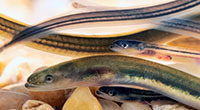 6/30 – Hudson River Estuary: In one of the most successful Community Science projects anywhere, DEC's Hudson River Estuary Staff and Partners collected a record number of glass eels (American eels) during a migration season that began in March and finished at the end of May. The 400,000 glass eels captured were more than any other year since the project began in 2008. During those 13 years, scientists and volunteers have counted more than one million glass eels. This year's sampling season was very different as volunteers were unable to participate due to COVID-19. DEC staff and environmental partners followed robust safety and social distancing protocols to monitor four stream sites for a full season. (Tom McDowell photo) 6/30 – Hudson River Estuary: In one of the most successful Community Science projects anywhere, DEC's Hudson River Estuary Staff and Partners collected a record number of glass eels (American eels) during a migration season that began in March and finished at the end of May. The 400,000 glass eels captured were more than any other year since the project began in 2008. During those 13 years, scientists and volunteers have counted more than one million glass eels. This year's sampling season was very different as volunteers were unable to participate due to COVID-19. DEC staff and environmental partners followed robust safety and social distancing protocols to monitor four stream sites for a full season. (Tom McDowell photo)
- DEC's Hudson River Estuary Staff and Partners
[The life history of the American eel (Anguilla rostrata) is cloaked in mystery, from beginning to end. Glass eels are one of their juvenile life stages. They arrive in the estuary by the millions each spring following a six-month to year-long journey from the greater Sargasso Sea area of the North Atlantic where we think they are born. Glass eel is a colloquial name, owing to their lack of pigment and near transparency. In anywhere from 12-30 years, depending upon their sex, they will leave the Hudson River watershed for the sea where they will spawn once and then die, or so we think.
Glass eels are collected using specialized nets and traps (fyke nets and eel mops), counted, weighed, and released into their upstream habitat, often above dams. The Hudson River Eel Project, managed by DEC’s Hudson River Estuary Program and Hudson River National Estuarine Research Reserve, gathers these data to help guide management plans for eel conservation and to engage communities in researching their local stream environments. Chris Bowser, Sarah Mount]
Natural History Entries
6/20 – North Germantown, HRM 109: The new-moon tide with its extra draw had emptied the inshore shallows. We had to walk a hundred yards off the beach to find the river. It was heartening to see emerging beds of wild celery (Vallisneria americana) where, in recent years, it had struggled. The shallows were thick with clouds of young-of-year fishes of several species, including hundreds of tiny striped bass (22-29 millimeters (mm)) and one young-of-year freshwater drum (25 mm), the first one we had ever caught.
We considered the recurring miracle of these young-of-year fishes, an event that was part of springtime in the river long before any of us were here to witness. The countless numbers of young-of-year were from a half-dozen species, some of which were destined to travel 120 miles downriver to the sea by summer’s end. The significance of the moment went far beyond the numbers. We discovered how often our language is inadequate to describe the wonders of our world. We also wondered what the patron saint of wilderness philosophers would have to say about this dilemma:
“... any good poet, in our age at least, must begin with the scientific view of the world; and any scientist worth listening to must be something of a poet, must possess the ability to communicate to the rest of us his sense of love and wonder at what his work discovers.” Edward Abbey, The Journey Home
At 5:43 PM, with a blue haze on the Catskills, the Summer Solstice arrived at the river. Cooled by a soft south breeze, we stood in the river up to our knees and took in the onset of summer. The nature of the scene—the air, the water, the land—blended seamlessly with the science of its parts.
- Tom Lake, A. Danforth
(one inch = 25.4 millimeters (mm))
6/20 – Millbrook, HRM 82: I found a freshly-killed groundhog, and I placed it in front of one of my trail cameras. The groundhog was gone by the next afternoon, and my camera revealed a progression of diners that was about what one might have expected.
The first on the scene were turkey vultures cruising low over the fields with their finely tuned sense of smell. American black vultures came second; these vultures fly at higher elevations and have a poor sense of smell but are quick to spot successful turkey vultures and join in. After a while, the black vultures were routed by the third visitor, a bald eagle. The bald eagle fed for a while before it too flew off. The vultures eventually came back until they were once again routed, this time by a coyote that carried off the groundhog and put an end to the show.
- Nelson Johnson
[This scenario goes to the message that we offer our students: In nature, particularly with road kills, from squirrels to woodchucks to white-tailed deer, nothing goes to waste. Tom Lake]
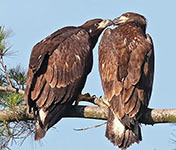 6/20 – Town of Poughkeepsie: The three nestlings-turned-fledglings from bald eagle nest NY372 were out of the nest and discovering their world. Two of them perched side-by-side today on a nearby limb communicating to each other in ways known only to eagles. (Dana Layton photo) 6/20 – Town of Poughkeepsie: The three nestlings-turned-fledglings from bald eagle nest NY372 were out of the nest and discovering their world. Two of them perched side-by-side today on a nearby limb communicating to each other in ways known only to eagles. (Dana Layton photo)
- Dana Layton
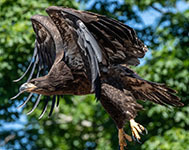 6/21 – Town of Poughkeepsie: It had been ten days since the sole nestling in bald eagle nest NY62 had become a fledgling. The question was, how long will it stick around the nest and its parents? Each season and each fledgling are unique. Their learning curve toward self-reliance can vary from a week to more than a month, depending on many factors. No two seasons and no two fledglings are the same. (Bob Rightmyer photo) 6/21 – Town of Poughkeepsie: It had been ten days since the sole nestling in bald eagle nest NY62 had become a fledgling. The question was, how long will it stick around the nest and its parents? Each season and each fledgling are unique. Their learning curve toward self-reliance can vary from a week to more than a month, depending on many factors. No two seasons and no two fledglings are the same. (Bob Rightmyer photo)
- Bob Rightmyer
6/22 – Minerva, HRM 284: It has been so much fun getting out into the woods and wetlands this spring, getting wet and bug-bitten. I was out on a bog mat today where I found pitcher plants, rose pogonia, Labrador tea, sheep laurel, great Sphagnum mosses, and more. While getting to the mat I flushed out an American bittern and a snipe and heard a wood thrush.
Along the Boreas River in Minerva, I heard a bird song that I had not come across in a long while: a Swainson's thrush, also known as the olive-backed thrush(Catharus ustulatus). They have a rising song, the opposite of a veery. Along the beautiful DEC loop trail on the east side of the Boreas River there were plenty of botanical delights, including blooming twinflower and bunchberry. Flowers to-be included dewberry, trailing arbutus, snowberry, and wintergreen.
- Mike Corey
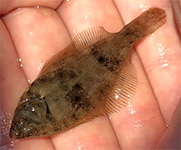 6/23 – Manhattan, New York City: Our Randall's Island Park Alliance finally had an opportunity to put out our fish traps this week. Yesterday, Elizabeth Reeve and I set a killifish pot in the Harlem River off the ferry dock across from Manhattan’s East 120th Street. Today, we checked it to find a naked goby (40 mm) and a yearling (Class of 2019) winter flounder (60 mm). The pot also held 26 eastern mud dog whelk snails (Tritia obsoleta) ranging from the size of a macadamia nut to that of a peanut M&M. The salinity was 16.0 parts-per-thousand (ppt), and the water temperature was 72 degrees Fahrenheit (F). (Jackie Wu photo) 6/23 – Manhattan, New York City: Our Randall's Island Park Alliance finally had an opportunity to put out our fish traps this week. Yesterday, Elizabeth Reeve and I set a killifish pot in the Harlem River off the ferry dock across from Manhattan’s East 120th Street. Today, we checked it to find a naked goby (40 mm) and a yearling (Class of 2019) winter flounder (60 mm). The pot also held 26 eastern mud dog whelk snails (Tritia obsoleta) ranging from the size of a macadamia nut to that of a peanut M&M. The salinity was 16.0 parts-per-thousand (ppt), and the water temperature was 72 degrees Fahrenheit (F). (Jackie Wu photo)
- Jackie Wu
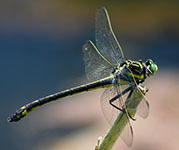 6/24 – Ulster County, HRM 79: Dragonhunting was great right now! On my way back down the trail at the John Burroughs Nature Sanctuary, a monstrous dragonfly caught my eye as it perched on a lakeside branch. Bright green eyes, a brilliant yellow color (typical of Gomphids), thick yet somehow gangly legs—it could only be one thing: a dragonhunter! At more than three-inches-long, this giant is truly a sight to behold. As the name suggests, dragonhunters will catch and eat darners and skimmers, along with bees, wasps, and larger butterflies like swallowtails and monarchs. 6/24 – Ulster County, HRM 79: Dragonhunting was great right now! On my way back down the trail at the John Burroughs Nature Sanctuary, a monstrous dragonfly caught my eye as it perched on a lakeside branch. Bright green eyes, a brilliant yellow color (typical of Gomphids), thick yet somehow gangly legs—it could only be one thing: a dragonhunter! At more than three-inches-long, this giant is truly a sight to behold. As the name suggests, dragonhunters will catch and eat darners and skimmers, along with bees, wasps, and larger butterflies like swallowtails and monarchs.
I have seen a few anecdotal reports of dragonhunter nymphs for Ulster County, but I do not believe there are any records of adults. I certainly did not expect to find one during my lunch break at the John Burroughs Nature Sanctuary! (Frank Beres photo)
- Frank Beres
 6/24 – Beacon, HRM 61: Sometimes you guess wrong on the appropriate gear for a job on the river. The Hudson was rife with young-of-year fishes today of several species and while the small-mesh (5.0 mm) net we chose seemed adequate, we watched helplessly as a steady stream of impossibly tiny fishes emptied out of the seine back into the swash. Those we were able to collect were mostly spottail shiners (15-20 mm), but there were many unknowns. Following three weeks of hot weather, the river had warmed to 79 degrees F. With very little rainfall, the salinity had risen to 3.5 ppt. (Tom Lake photo) 6/24 – Beacon, HRM 61: Sometimes you guess wrong on the appropriate gear for a job on the river. The Hudson was rife with young-of-year fishes today of several species and while the small-mesh (5.0 mm) net we chose seemed adequate, we watched helplessly as a steady stream of impossibly tiny fishes emptied out of the seine back into the swash. Those we were able to collect were mostly spottail shiners (15-20 mm), but there were many unknowns. Following three weeks of hot weather, the river had warmed to 79 degrees F. With very little rainfall, the salinity had risen to 3.5 ppt. (Tom Lake photo)
- Tom Lake, A. Danforth
6/24 – Bedford, HRM 35: The great blue heron rookery was now down to a single nestling with its two siblings having fledged. The other two nestlings had also fledged. The single remaining nestling was actively preening its feathers. To a heron, preening appears to be a compulsive behavior much like a cat grooming itself. During my short time there, no adults showed up for feeding. Fewer feeding visits encourages nestlings to fledge and learn to hunt on their own. While the nests were more than a hundred yards away and passing traffic did not bother them, large, noisy utility trucks recently replacing power poles might have caused the two incubating herons to abandon their nests.
- Jim Steck
6/24 – Manhattan, New York City: It's always a good day at the Randall's Island Park Alliance when there are fish around! Elizabeth Reeve checked our fish trap this morning and found a naked goby and ten more eastern mud dog whelk snails. Elizabeth then reset the trap. Later in the day, we found one lone mud dog whelk snail. We're hoping to add in a few more traps as we slowly return to a more regular schedule.
- Jackie Wu
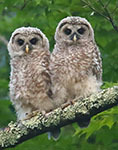 6/25 – Town of Catskill, HRM113: While on our deck in Palenville this evening, we heard what we thought were baby barred owl sounds. We walked around to check it out and found two fledgling barred owls perched side-by-side high up on a dead snag. (Larry Federman photo) 6/25 – Town of Catskill, HRM113: While on our deck in Palenville this evening, we heard what we thought were baby barred owl sounds. We walked around to check it out and found two fledgling barred owls perched side-by-side high up on a dead snag. (Larry Federman photo)
- Larry Federman
6/26 – Esopus Meadows, HRM 87: I used to go fishing on the Hudson River when I was younger, but I am now unable to get out like I used to. Today, I decided to just turn back the clock and go rod and reel fishing. With only some nightcrawlers and bare-hook rigs, I went to the river off a point of land at Esopus Meadows. It was magic. In less than three hours, I caught six handsome smallmouth bass, three gorgeous yellow perch, a 15-inch bruiser largemouth bass, a pumpkinseed sunfish, and a small white perch—an even dozen fish. Although I love a nice fresh fillet, all of these were safely released.
- Richard Rizza
[While there are as many ways to recreationally fish the Hudson River as there are stars (anglers) in the sky, this has to be considered the quintessential Hudson River fishing trip! Tom Lake]
6/26 – Little Stony Point, HRM 55: In reading natural history journal exploits and adventures, it would seem that the sun is always shining, the fish are always jumping, the eagles are always flying, white-tailed deer are eager to pose for you with doe-eyes, and sunrises and sunsets are just spectacular. I suppose if it were otherwise, no one would derive much inspiration from reading about mediocre adventures.
The same is true of our seining adventures on the river. While many of them are fruitful, in one way or another, there are days when we are forced to reprise the old grad-school axiom, “No data is still data.” Today was one of those. The fish may have been there in abundance but, when we unfurled our thirty-foot seine, we were staring at a hole in the bag large enough to fit a sea turtle through. Then, I remembered that the last time we used the net, we had a snag, a tear, and then we forgot to mend it. Just embarrassing.
- Tom Lake, Eli Schloss
[We were still in a drought. For the first 26 days of June, we had only 0.38 inches of rain. The salinity had risen to 4.5 ppt, and the river was 74 degrees F. Tom Lake]
*** Fish of the Week ***
 6/26 – Hudson River Watershed: Fish-of-the-Week for Week 76 is the Atlantic croaker (Micropogonias undulatus) number 191 (of 231), on our Hudson River Watershed List of Fishes. If you would like a copy of our list, e-mail: trlake7@aol.com 6/26 – Hudson River Watershed: Fish-of-the-Week for Week 76 is the Atlantic croaker (Micropogonias undulatus) number 191 (of 231), on our Hudson River Watershed List of Fishes. If you would like a copy of our list, e-mail: trlake7@aol.com
[The Atlantic croaker is one of seven members of the drum family (Sciaenidae) found in our watershed, some of which have specially developed swim or air bladders that can produce a “croaking” or “drum” sound. Others include freshwater drum, silver perch, weakfish, spot (Lafayettes), northern kingfish, and black drum.
Croakers, known colloquially to anglers as “hardheads,” are found along the Atlantic coast from Massachusetts to the Gulf of Mexico but are more common in the southern end of their range. They spawn offshore after which their young-of-year move to inshore waters in summer and fall. They are not uncommon in the lower estuary from summer through early autumn. The largest croakers can reach 18-24-inches and weigh just over two pounds. Their trivial name undulatus translates from Latin as “wavy,” a tribute to their subtle color pattern, an adaption to concealment which allows them to dissolve into background shadows. (Tom Lake photo)
- Tom Lake
6/27 – Greene County: On this day in 1997, a bald eagle nestling became a fledgling for the first time in 100 years. Pete Nye, who had banded the bird in May with a blue DEC leg band F20, felt that it was a male based on talon measurements. In all his awkward young grandeur, on this day we saw him flying along the shoreline with his parents.
He had successfully fledged but little did he know what this represented. After an absence of more than 100 years, bald eagles had once again nested successfully along the Hudson River. (Bald eagles were last known to nest near West Point in 1890 with the last successful fledge in 1897.)
Pete Nye felt, and time has proven him correct, that bald eagles had finally “breached the barrier” of nesting along the Hudson and was confident that great things were in store for them.
- Tom Lake
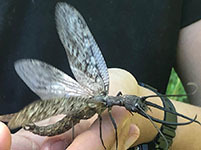 6/27 – Hyde Park, HRM 82: While installing an American eel ladder on Crum Elbow Creek, we stumbled upon a gorgeous adult male eastern dobsonfly (Corydalus cornutus). Anyone spending time in fast moving streams may have encountered the larval form of this insect called a hellgrammite. Despite the male's incredible sickle-shaped mandibles, they do not bite. Or at least this one didn't, and he safely flew off into the riparian brush. (Chris Bowser photo) 6/27 – Hyde Park, HRM 82: While installing an American eel ladder on Crum Elbow Creek, we stumbled upon a gorgeous adult male eastern dobsonfly (Corydalus cornutus). Anyone spending time in fast moving streams may have encountered the larval form of this insect called a hellgrammite. Despite the male's incredible sickle-shaped mandibles, they do not bite. Or at least this one didn't, and he safely flew off into the riparian brush. (Chris Bowser photo)
- Amanda Simmonds, Chris Bowser, Chelsea Moore
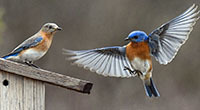 6/27 – Putnam County, HRM 52: Our yard’s bluebird house yielded four healthy fledglings last week and, for the first time in many years of maintaining bluebird houses, we happened to be watching as the fledging occurred. 6/27 – Putnam County, HRM 52: Our yard’s bluebird house yielded four healthy fledglings last week and, for the first time in many years of maintaining bluebird houses, we happened to be watching as the fledging occurred.
Over several hours, two females and two males emerged and, with the encouragement of their parents, hopped out of the house entrance hole and took flight. The females were quick out and on their way. The males needed long periods of encouragement. They would poke their heads out, then their shoulders, then retreat back in. The parents brought them many bugs and the Dad even resorted to placing a bug on the roof of the house which did, indeed, coax one of the males out into the world. Watching these four little bluebirds enter the world was moving, and we witnessed something very fundamental to Nature. All four babies and parents have since been seen around the yard. (Tom McDowell photo)
- Tom Fine, Leslie Fine
6/27 – Bedford, HRM 35: I stopped by the great blue heron rookery today to see if the remaining nestling had fledged, but was surprised to see four herons, two in each nest. Their vocalizing was quite noisy, and they were looking to the sky for their parents to return with fish. They all will move on when they get hungry enough.
- Jim Steck
6/28 – Waterford, HRM 157: This was Week Nine for bald eagle nest NY485 at Peebles Island State Park. The two nestlings were branching, one more than the other, discovering the structure of the nest tree, limb-to-limb. There was evidence that one nestling may be more advanced than the other, for reasons of sex or simply personality–they are all individuals. It was also the week of the eels! The adults brought into the nest no fewer than five American eels in about a half-hour. The drought conditions may have left eels more vulnerable in the nearby shallow water.
- Howard Stoner
6/28 – Little Stony Point, HRM 55: With little freshwater input into the estuary this month, the salinity had risen to just over 4.5 ppt. Our surprise catch today was young-of-year bluefish (69-71 mm). These are slim, silvery-bright fishes with strong jaws and sharp teeth. They are born in the saltwater of the New York Bight after which the young-of-year head upriver in late spring where their chance of survival is greater, and the food supply is nearly unlimited. Evidence of their presence today was detected before we saw the first of them: there were chopped, partially eaten, and regurgitated spottail shiners in the net—bluefish are messy eaters. In a continuance of recent catches, we also found a hundred or more young-of-year striped bass (19-38 mm). The river was 77 degrees F.
- Tom Lake, T.R. Jackson
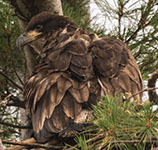 6/29 – Northeast Dutchess County: Bald eagle nest NY487, a territory that we have dubbed the “Pine Tree Family,” was in its fourth year. This season they had a single, healthy nestling that today looked ready to fledge. (Carol Pedersen photo) 6/29 – Northeast Dutchess County: Bald eagle nest NY487, a territory that we have dubbed the “Pine Tree Family,” was in its fourth year. This season they had a single, healthy nestling that today looked ready to fledge. (Carol Pedersen photo)
- Deborah Tracy Kral
[Update: July 7. I watched the nestling the other night in a surreal setting when a squall hit. It was balanced far out on a limb and seemed to be in trouble. But the nestling used breaks in the gusts to slowly inch back toward the nest. I stayed just in case it got in trouble and was so relieved when it sort-of "fell" back into the nest! And then, today, I think the nestling fledged! Deborah Tracy Kral]
6/29 – Manitou, HRM 46.5: We were able to verify there were three nestlings in bald eagle nest NY527 this spring. The last we saw of them, they all looked healthy, very active—much hopping and wing flapping—and nearly the size of the adults. We watched fish deliveries but had to cut our viewing short since our vantage point was from along the railroad tracks and the Metro North police would not allow that. We never witnessed the actual fledging.
- Owen Sullivan, Zshawn Sullivan
6/30 – Waterford, HRM 157: It was fledge-week at bald eagle nest NY485. The first of two nestlings we believed to be a male, left today by what seemed to be the result of a fall straight down,15-20 feet, to a limb. [He hung out there for two days before making it down to the beach and getting food from its parents.]
- Howard Stoner
[First flights can be an adventure. The first bald eagle fledge that I witnessed was a male from NY62 in 2004. On his maiden flight, he discovered that spruce trees are not a prime selection for landing. He bounced off the tree and fell 20 feet to the ground, unhurt. A female fledgling in 2005 did little better. She aimed for a whippy limb near the top of a tall maple, missed the landing, and then cascaded down inside the tree, upside-down, before grabbing onto a limb near the bottom. She hung there upside-down for more than an hour until she let go and dropped to the ground, unhurt. Tom Lake]
 6/30 – Ulster County, HRM 79: I spent a few minutes today observing several male banded pennants, dragonflies (Celithemis fasciata), hovering and briefly perching near the lake at John Burroughs Nature Sanctuary. These are fairly common in eastern North America, but somewhat rare to find in New York. No previous records exist for Ulster County, although I did see a mating pair last year at Onteora Lake. (Frank Beres photo) 6/30 – Ulster County, HRM 79: I spent a few minutes today observing several male banded pennants, dragonflies (Celithemis fasciata), hovering and briefly perching near the lake at John Burroughs Nature Sanctuary. These are fairly common in eastern North America, but somewhat rare to find in New York. No previous records exist for Ulster County, although I did see a mating pair last year at Onteora Lake. (Frank Beres photo)
- Frank Beres
6/30 – Ulster County, HRM 79: I found what might be only the second record of the northern oak hairstreak butterfly (Satyrium favonius ontario) at the John Burroughs Nature Sanctuary in Ulster County. Consequently, it could be the second northernmost record for the species in the state—a historical record exists for a sighting in 1989. In New York, this species occurs mostly in the lower Hudson Valley and on Long Island. Their distribution also includes Ithaca and the Albany Pine Bush where one was collected in 1979, but those populations are presumed to be extirpated.
- Frank Beres
[To be, or not to be ...
+Extant means populations that are still found in a specific area, such as black bears and bobcats.
Extirpated means a species that is no longer found in a specific area but does exist elsewhere, for example the gray wolf and mountain lions. Extinct means they no longer exist, are gone forever, like the American mastodon, woolly mammoth, and the passenger pigeon. Tom Lake]
7/1 – Saugerties, HRM 102: Anna Landewe briefly spotted our male harbor seal this evening from the Saugerties Lighthouse deck just before it disappeared underwater. The seal’s longevity in Esopus Creek, 113 miles from the open sea, was now 320 days.
- Patrick Landewe
7/1 – Bedford, HRM 35: The great blue heron rookery was now empty, with the remaining five herons fledged. The four that returned to their nests on my last visit was an indicator that they had achieved good flying and navigation skills. This year the rookery was not as productive as in past years. However, in two years, those herons that fledged here will reach sexual maturity and start their own families.
- Jim Steck
7/2 – Newcomb, HRM 302: June began as a dry month but finished with a bit of rain. Still, the 2.85-inches were an inch below our monthly average. It was a hot month as well with the daily high temperature two degrees Fahrenheit above average.
As for our wildlife, of the six lakes we survey for common loon nesting, three of them had confirmed nests. We have our fingers crossed for successful hatching, but the low water level on those lakes makes it difficult for the birds to climb on and off their nests. This also exposes both the nest and the birds to predators. As expected, last autumn’s bumper crop of beech nuts and other seeds resulted in a chipmunk and other small mammal explosion. We can barely walk fifty yards in the woods without scaring up a chipmunk or being scolded by one from a nearby stump. This means that fox, coyote, bobcat, owls, hawks and other predators should do well this year.
- Charlotte Demers
 7/2 – Beacon, HRM 61: While surveying my New York State Breeding Bird atlas block today, I came upon an exciting mix of wildlife along Fishkill Creek. I watched a blue gray gnatcatcher over my head as it tried to drive away a pair of brown-headed cowbirds. (The cowbirds eventually left but I do not think they were scared off by the gnatcatcher.) 7/2 – Beacon, HRM 61: While surveying my New York State Breeding Bird atlas block today, I came upon an exciting mix of wildlife along Fishkill Creek. I watched a blue gray gnatcatcher over my head as it tried to drive away a pair of brown-headed cowbirds. (The cowbirds eventually left but I do not think they were scared off by the gnatcatcher.)
I had been listening to marsh wrens and, while trying to get a recording, I heard a loud squawking coming from a great blue heron that had been preening on a snag across the water. The bird was now in the water, and a bobcat was in the tree where the heron had been preening. The blue heron continued to squawk and eventually took off. By then, the marsh wrens were no longer singing, but I didn't really care. The bobcat drama had already made my day. (Susan Iannucci photo)
- Susan Iannucci (Ralph T. Waterman Bird Club)
7/2 – Kowawese, HRM 59: At low tide, the inshore shallows were beyond tepid at 83 degrees F. This was the result of cumulative warming---15 of the last 16 days had been over 80 degrees; four days greater than 90 degrees. Most of our seine catch was young-of-year striped bass (25-40 mm). While we caught no bluefish, evidence of their presence was apparent in the many aft-ends of small fish that were missing their heads. Salinity was steady at 3.5 ppt.
- Tom Lake, Phyllis Lake
7/3 – Little Stony Point, HRM 55: At faint first light, the Hudson Highlands were a muted black-and-white. As we stepped on the sand, we caught the tail end of a coyote light-footing it down the beach. We netted the last of the down tide and found scores of yearling white perch—nothing else. Patience. Sunrise came with the start of the flood tide and our bag filled with small schools of young-of-year bay anchovies (63-81 mm) and striped bass (25-45 mm). The river was 77 degrees F and, despite some local cloudbursts, the salinity remained at 3.5 ppt.
- Tom Lake, A. Danforth
[Artists and photographers have long revered sunsets in their work—the Hudson River School of painting comes to mind. But for me, I’ll take sunrise. The growing glow from first light to dawn to sunrise is a study in anticipation, rebirth, renewal, and dawn of a new day. Tom Lake]
 7/3 – Little Stony Point, HRM 55: During a beach-walk this morning, we came upon ten dead Atlantic menhaden (Brevoortia tyrannus) that had been left on the sand by the dropping tide. This was not totally unexpected. In the last week, numbers of menhaden have been found floating dead in the river in a sixty-mile reach from the Hudson Highlands south to the Upper Bay of New York Harbor giving rise to concerns over water quality. To better understand this phenomenon, we have to discuss the fish. 7/3 – Little Stony Point, HRM 55: During a beach-walk this morning, we came upon ten dead Atlantic menhaden (Brevoortia tyrannus) that had been left on the sand by the dropping tide. This was not totally unexpected. In the last week, numbers of menhaden have been found floating dead in the river in a sixty-mile reach from the Hudson Highlands south to the Upper Bay of New York Harbor giving rise to concerns over water quality. To better understand this phenomenon, we have to discuss the fish.
Some naturalists see the Atlantic menhaden as a tortured species, born with a death wish. They are a saltwater herring, born at sea, but spend much of their lives in brackish water. Along the Atlantic Coast they are found from Nova Scotia to Florida and can reach 14-inches in length. From very early on, as young-of-year, they become a target of many predators, including bluefish and striped bass, seals, dolphins, and whales, as well as eagles and osprey. They are the “Snickers” bars of the sea.
Adults, also known regionally as bunker, mossbunker, pogies, or fatback, and their young-of-year that anglers refer to, colloquially, as peanut bunker or penny bunker, are found by the many millions in the estuary each summer and fall (in November 2016, a humpback whale entered the Upper Bay of New York Harbor to prey on huge schools of Atlantic menhaden).
However, Atlantic menhaden are very sensitive to environmental conditions. For more than a month, there had been little rainfall, very low freshwater input (flushing) into the system, plus a quick rise in water temperature (82 degrees F in the shallows) resulting in a subsequent drop in dissolved oxygen creating hypoxia. Adding these conditions to the inherent sensitivity of the species, the estuary had become a very stressful environment. The result was death by a lack of sufficient dissolved oxygen.
While Climate Change may be a contributing factor, these conditions have been challenging the fragility of Atlantic menhaden long before we were here to notice it. From that perspective, this is a natural occurrence, an annual phenomenon, something that a bout of rainfall will correct. In the meantime, the menhaden will suffer, but the blue crabs and American eels will feast.
For more information on Atlantic menhaden, see John Waldmans’ Heartbeats in the Muck: The History, Sea Life, and Environment of New York Harbor (2012). In it, Waldman mentions how the early Dutch of New Amsterdam witnessed a menhaden kill, similar to this one, in a Staten Island creek 350 years ago. Perhaps the best book on the Atlantic menhaden is H. Bruce Franklin’s The Most Important Fish in the Sea: Menhaden and America (2008). (Tom Lake photo)
- Tom Lake
[Atlantic Menhaden are plankton filter-feeders and therefore are a significant link between plankton productivity and population health of predatory fishes. Menhaden are a significant economic resource, being harvested for fish meal and fish oil. In 2018, 191,000 metric tons of menhaden were harvested from US waters. Bob Schmidt]
*** Fish of the Week***
 7/3 – Hudson River Watershed: Fish-of-the-Week for Week 78 is the northern tonguefish (Symphurus pusillus) number 223 (of 231), on our Hudson River Watershed List of Fishes. If you would like a copy of our list, e-mail: trlake7@aol.com 7/3 – Hudson River Watershed: Fish-of-the-Week for Week 78 is the northern tonguefish (Symphurus pusillus) number 223 (of 231), on our Hudson River Watershed List of Fishes. If you would like a copy of our list, e-mail: trlake7@aol.com
[The northern tonguefish is a small, flatfish, much like a flounder, and along with the hogchoker, are the two members of the sole family (Soleidae) in the watershed. Both of their eyes are on the left side of their head, like a summer flounder. The northern tonguefish is found from Massachusetts to North Carolina and are considered to be a temperate marine stray in the estuary. The northern tonguefish was added to our Hudson River Watershed List of Fishes on October 1, 1991, from two fishes (39, 44 mm) caught by DEC’s Kim McKown at river mile 24 (Tappan Zee). Their maximum size is 75 mm. (Photo courtesy of Fish Base)
- Tom Lake
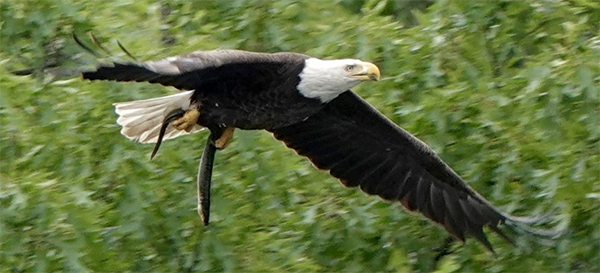
Summer-Fall 2020 Natural History Programs
DEC Trees for Tribs: The Hudson River Estuary Program’s “Trees for Tribs” program offers free native trees and shrubs for planting along the tributary streams in the Hudson River Estuary watershed and is now accepting applications (deadline is August 1). Our staff can help you with a planting plan. Since 2007, Trees for Tribs has provided more than 40,000 native trees and shrubs for planting along 20 miles of stream with the help of more than 9,000 local volunteers. We are now accepting applications for planting projects.
For more information about the program or to download an application, please visit the DEC website at: https://www.dec.ny.gov/lands/43668.html. If you have questions about a potential planting site, please contact Beth Roessler at HudsonEstuaryTFT@dec.ny.gov.
2020 "I BIRD NY" Challenge
New York State Department of Environmental Conservation (DEC) Commissioner Basil Seggos today announced the start of the 2020 "I BIRD NY" challenges for beginner and experienced birders. The I BIRD NY program was launched by Governor Andrew M. Cuomo in 2017, to build on the State's efforts to increase access to New York's vast natural resources and promote low-cost opportunities to explore the great outdoors and connect with nature. New York is home to a wide range of habitats that support more than 450 different bird species throughout the year. There are also 59 designated Bird Conservation Areas to safeguard and enhance bird populations and habitats on State lands and waters across the state.
DEC is hosting its annual I Bird NY Beginner's Birding Challenge, which is open to anyone 16 years of age and younger. To complete the Beginner's Birding Challenge, participants must identify 10 common New York bird species and submit their challenge sheet to DEC. Entries can be mailed or emailed. All participants in this challenge will receive a certificate of participation and be entered into a random drawing for a chance to win birding accessories. For information, go to: https://www.dec.ny.gov/docs/administration_pdf/begbirdchallenge2019.pdf
In addition to the Beginner's Birding Challenge, DEC is offering the I Bird NY Experienced Birder Challenge. To complete the challenge, birders of any age must identify at least 10 different bird species found across New York State. All participants in this challenge will also receive a certificate of participation and be entered into a drawing for birding accessories. For information, go to: https://www.dec.ny.gov/docs/administration_pdf/expbchallenge2019.pdf
During the COVID-19 public health crisis, getting outside for a nature break is more important than ever and DEC will continue to encourage new and experienced naturalists alike to participate safely and responsibly in birding and other outdoors activities."
- NYSDEC
DEC advises New Yorkers to take measures to reduce bear conflicts
State Department of Environmental Conservation (DEC) Commissioner Basil Seggos reminds New Yorkers to take steps to reduce conflicts with bears. Feeding bears either intentionally, which is illegal, or unintentionally through careless practices around properties, has consequences for entire communities. DEC advises everyone who lives in or visits bear habitat, which is much of Upstate New York, to remove items that are attractive to bears. People should take down bird feeders by April 1, store garbage inside secure buildings, and feed pets indoors. These actions are necessary to live responsibly with black bears, protect people, property, and bears. For more information about how to reduce human/bear conflicts, visit DEC's website.
Guidelines on how to avoid problems with black bears: http://www.dec.ny.gov/press/113258.html
DEC Seeks Birdwatchers to contribute to 2020 Breeding Bird Atlas
State Department of Environmental Conservation (DEC) Commissioner Basil Seggos has announced a call for citizen-science volunteers to help in the development of a comprehensive, statewide survey that takes place every two decades to detail New York’s breeding bird distribution. Starting in 2020, five years of field surveys will be conducted by volunteers and project partners to provide the data that will be analyzed to create the third New York State Breeding Bird Atlas.
“Just as New Yorkers are embarking on the 2020 Census to track human populations and trends, DEC and our partners track our natural populations to evaluate the effectiveness of New York’s programs and initiatives to promote diverse and healthy wildlife,” Commissioner Seggos said. “The Breeding Bird Atlas is a valuable tool to help protect birds and habitat, and I encourage all New Yorkers to get outdoors safely and responsibly and participate in this year’s survey while practicing social distancing.”
DEC is partnering with the New York Natural Heritage Program, SUNY College of Environmental Science and Forestry (ESF), Audubon New York, Cornell Lab of Ornithology, New York State Ornithological Association, and New York Cooperative Fish and Wildlife Research Unit on this project. When complete, the atlas will provide species-specific details about distribution, maps, and illustrations.
The last atlas was published in 2008, with information on its results available on DEC’s website. Five years of fieldwork by more than 1,200 contributors provided the data for the second addition to New York’s understanding of the state’s avifauna (birds). This substantial book revealed striking changes in the distributions of many of our breeding birds since New York's first Breeding Bird Atlas was published in 1988. Data showed that half of New York’s 253 species showed a significant change in their distribution, with 70 species showing increases and 58 species showing declines. A comparison study between the first two atlases showed that the distribution of 129 species moved northward an average of 3.58 kilometers due to climate change. The 2020 atlas will provide further data on this shift and climate change’s potential impact on wildlife.
To participate, volunteers can make a free eBird account and submit data online through the atlas website (ebird.org/atlasny) or via the eBird mobile app. Simply record the species and any breeding behaviors observed. All sightings can count. As observations are reported, data can be viewed here: https://ebird.org/atlasny/state/US-NY.
Hudson River Miles
The Hudson is measured north from Hudson River Mile 0 at the Battery at the southern tip of Manhattan. The George Washington Bridge is at HRM 12, the Tappan Zee 28, Bear Mountain 47, Beacon-Newburgh 62, Mid-Hudson 75, Kingston-Rhinecliff 95, Rip Van Winkle 114, and the Federal Dam at Troy, the head of tidewater, at 153. The tidal section of the Hudson constitutes a bit less than half the total distance – 315 miles – from Lake Tear of the Clouds to the Battery. Entries from points east and west in the watershed reference the corresponding river mile on the mainstem.
To Contribute Your Observations or to Subscribe
The Hudson River Almanac is compiled and edited by Tom Lake and emailed weekly by DEC's Hudson River Estuary Program. Share your observations by e-mailing them to trlake7@aol.com.
To subscribe to the Almanac (or to unsubscribe), use the links on DEC's Hudson River Almanac or DEC Delivers web pages.
Discover New York State
The Conservationist, the award-winning, advertisement-free magazine focusing on New York State's great outdoors and natural resources. The Conservationist features stunning photography, informative articles and around-the-state coverage. Visit The Conservationist webpage for more information.
Useful Links
National Oceanic and Atmospheric Administration online tide and tidal current predictions are invaluable when planning Hudson River field trips.
For real-time information on Hudson River tides, weather and water conditions from sixteen monitoring stations, visit the Hudson River Environmental Conditions Observing System website.
DEC's Smartphone app for iPhone and Android is now available at: New York Fishing, Hunting & Wildlife App.
NY's Outdoors Are Open
#RecreateLocal-- Safely and Responsibly
DEC and Office of Parks, Recreation and Historic Preservation (State Parks) are encouraging New Yorkers to engage in responsible recreation during the ongoing COVID-19 public health crisis. DEC and State Parks recommendations incorporate guidance from the Centers for Disease Control and Prevention and the New York State Department of Health for reducing the spread of infectious diseases and encourage New Yorkers to recreate locally, practice physical distancing, and use common sense to protect themselves and others. In addition, DEC and State Parks launched a new hashtag-#RecreateLocal-and encourage New Yorkers to get outside and discover open spaces and parks close to home.
Information about the Hudson River Estuary Program is available on DEC's website at http://www.dec.ny.gov/lands/4920.html.
|


 6/30 – Hudson River Estuary: In one of the most successful Community Science projects anywhere, DEC's Hudson River Estuary Staff and Partners collected a record number of glass eels (American eels) during a migration season that began in March and finished at the end of May. The 400,000 glass eels captured were more than any other year since the project began in 2008. During those 13 years, scientists and volunteers have counted more than one million glass eels. This year's sampling season was very different as volunteers were unable to participate due to COVID-19. DEC staff and environmental partners followed robust safety and social distancing protocols to monitor four stream sites for a full season. (Tom McDowell photo)
6/30 – Hudson River Estuary: In one of the most successful Community Science projects anywhere, DEC's Hudson River Estuary Staff and Partners collected a record number of glass eels (American eels) during a migration season that began in March and finished at the end of May. The 400,000 glass eels captured were more than any other year since the project began in 2008. During those 13 years, scientists and volunteers have counted more than one million glass eels. This year's sampling season was very different as volunteers were unable to participate due to COVID-19. DEC staff and environmental partners followed robust safety and social distancing protocols to monitor four stream sites for a full season. (Tom McDowell photo) 6/20 – Town of Poughkeepsie: The three nestlings-turned-fledglings from bald eagle nest NY372 were out of the nest and discovering their world. Two of them perched side-by-side today on a nearby limb communicating to each other in ways known only to eagles. (Dana Layton photo)
6/20 – Town of Poughkeepsie: The three nestlings-turned-fledglings from bald eagle nest NY372 were out of the nest and discovering their world. Two of them perched side-by-side today on a nearby limb communicating to each other in ways known only to eagles. (Dana Layton photo) 6/21 – Town of Poughkeepsie: It had been ten days since the sole nestling in bald eagle nest NY62 had become a fledgling. The question was, how long will it stick around the nest and its parents? Each season and each fledgling are unique. Their learning curve toward self-reliance can vary from a week to more than a month, depending on many factors. No two seasons and no two fledglings are the same. (Bob Rightmyer photo)
6/21 – Town of Poughkeepsie: It had been ten days since the sole nestling in bald eagle nest NY62 had become a fledgling. The question was, how long will it stick around the nest and its parents? Each season and each fledgling are unique. Their learning curve toward self-reliance can vary from a week to more than a month, depending on many factors. No two seasons and no two fledglings are the same. (Bob Rightmyer photo) 6/23 – Manhattan, New York City: Our Randall's Island Park Alliance finally had an opportunity to put out our fish traps this week. Yesterday, Elizabeth Reeve and I set a killifish pot in the Harlem River off the ferry dock across from Manhattan’s East 120th Street. Today, we checked it to find a naked goby (40 mm) and a yearling (Class of 2019) winter flounder (60 mm). The pot also held 26 eastern mud dog whelk snails (Tritia obsoleta) ranging from the size of a macadamia nut to that of a peanut M&M. The salinity was 16.0 parts-per-thousand (ppt), and the water temperature was 72 degrees Fahrenheit (F). (Jackie Wu photo)
6/23 – Manhattan, New York City: Our Randall's Island Park Alliance finally had an opportunity to put out our fish traps this week. Yesterday, Elizabeth Reeve and I set a killifish pot in the Harlem River off the ferry dock across from Manhattan’s East 120th Street. Today, we checked it to find a naked goby (40 mm) and a yearling (Class of 2019) winter flounder (60 mm). The pot also held 26 eastern mud dog whelk snails (Tritia obsoleta) ranging from the size of a macadamia nut to that of a peanut M&M. The salinity was 16.0 parts-per-thousand (ppt), and the water temperature was 72 degrees Fahrenheit (F). (Jackie Wu photo) 6/24 – Ulster County, HRM 79: Dragonhunting was great right now! On my way back down the trail at the John Burroughs Nature Sanctuary, a monstrous dragonfly caught my eye as it perched on a lakeside branch. Bright green eyes, a brilliant yellow color (typical of Gomphids), thick yet somehow gangly legs—it could only be one thing: a dragonhunter! At more than three-inches-long, this giant is truly a sight to behold. As the name suggests, dragonhunters will catch and eat darners and skimmers, along with bees, wasps, and larger butterflies like swallowtails and monarchs.
6/24 – Ulster County, HRM 79: Dragonhunting was great right now! On my way back down the trail at the John Burroughs Nature Sanctuary, a monstrous dragonfly caught my eye as it perched on a lakeside branch. Bright green eyes, a brilliant yellow color (typical of Gomphids), thick yet somehow gangly legs—it could only be one thing: a dragonhunter! At more than three-inches-long, this giant is truly a sight to behold. As the name suggests, dragonhunters will catch and eat darners and skimmers, along with bees, wasps, and larger butterflies like swallowtails and monarchs. 6/24 – Beacon, HRM 61: Sometimes you guess wrong on the appropriate gear for a job on the river. The Hudson was rife with young-of-year fishes today of several species and while the small-mesh (5.0 mm) net we chose seemed adequate, we watched helplessly as a steady stream of impossibly tiny fishes emptied out of the seine back into the swash. Those we were able to collect were mostly spottail shiners (15-20 mm), but there were many unknowns. Following three weeks of hot weather, the river had warmed to 79 degrees F. With very little rainfall, the salinity had risen to 3.5 ppt. (Tom Lake photo)
6/24 – Beacon, HRM 61: Sometimes you guess wrong on the appropriate gear for a job on the river. The Hudson was rife with young-of-year fishes today of several species and while the small-mesh (5.0 mm) net we chose seemed adequate, we watched helplessly as a steady stream of impossibly tiny fishes emptied out of the seine back into the swash. Those we were able to collect were mostly spottail shiners (15-20 mm), but there were many unknowns. Following three weeks of hot weather, the river had warmed to 79 degrees F. With very little rainfall, the salinity had risen to 3.5 ppt. (Tom Lake photo) 6/25 – Town of Catskill, HRM113: While on our deck in Palenville this evening, we heard what we thought were baby barred owl sounds. We walked around to check it out and found two fledgling barred owls perched side-by-side high up on a dead snag. (Larry Federman photo)
6/25 – Town of Catskill, HRM113: While on our deck in Palenville this evening, we heard what we thought were baby barred owl sounds. We walked around to check it out and found two fledgling barred owls perched side-by-side high up on a dead snag. (Larry Federman photo) 6/26 – Hudson River Watershed: Fish-of-the-Week for Week 76 is the Atlantic croaker (Micropogonias undulatus) number 191 (of 231), on our Hudson River Watershed List of Fishes. If you would like a copy of our list, e-mail:
6/26 – Hudson River Watershed: Fish-of-the-Week for Week 76 is the Atlantic croaker (Micropogonias undulatus) number 191 (of 231), on our Hudson River Watershed List of Fishes. If you would like a copy of our list, e-mail:  6/27 – Hyde Park, HRM 82: While installing an American eel ladder on Crum Elbow Creek, we stumbled upon a gorgeous adult male eastern dobsonfly (Corydalus cornutus). Anyone spending time in fast moving streams may have encountered the larval form of this insect called a hellgrammite. Despite the male's incredible sickle-shaped mandibles, they do not bite. Or at least this one didn't, and he safely flew off into the riparian brush. (Chris Bowser photo)
6/27 – Hyde Park, HRM 82: While installing an American eel ladder on Crum Elbow Creek, we stumbled upon a gorgeous adult male eastern dobsonfly (Corydalus cornutus). Anyone spending time in fast moving streams may have encountered the larval form of this insect called a hellgrammite. Despite the male's incredible sickle-shaped mandibles, they do not bite. Or at least this one didn't, and he safely flew off into the riparian brush. (Chris Bowser photo) 6/27 – Putnam County, HRM 52: Our yard’s bluebird house yielded four healthy fledglings last week and, for the first time in many years of maintaining bluebird houses, we happened to be watching as the fledging occurred.
6/27 – Putnam County, HRM 52: Our yard’s bluebird house yielded four healthy fledglings last week and, for the first time in many years of maintaining bluebird houses, we happened to be watching as the fledging occurred. 6/29 – Northeast Dutchess County: Bald eagle nest NY487, a territory that we have dubbed the “Pine Tree Family,” was in its fourth year. This season they had a single, healthy nestling that today looked ready to fledge. (Carol Pedersen photo)
6/29 – Northeast Dutchess County: Bald eagle nest NY487, a territory that we have dubbed the “Pine Tree Family,” was in its fourth year. This season they had a single, healthy nestling that today looked ready to fledge. (Carol Pedersen photo) 6/30 – Ulster County, HRM 79: I spent a few minutes today observing several male banded pennants, dragonflies (Celithemis fasciata), hovering and briefly perching near the lake at John Burroughs Nature Sanctuary. These are fairly common in eastern North America, but somewhat rare to find in New York. No previous records exist for Ulster County, although I did see a mating pair last year at Onteora Lake. (Frank Beres photo)
6/30 – Ulster County, HRM 79: I spent a few minutes today observing several male banded pennants, dragonflies (Celithemis fasciata), hovering and briefly perching near the lake at John Burroughs Nature Sanctuary. These are fairly common in eastern North America, but somewhat rare to find in New York. No previous records exist for Ulster County, although I did see a mating pair last year at Onteora Lake. (Frank Beres photo) 7/2 – Beacon, HRM 61: While surveying my New York State Breeding Bird atlas block today, I came upon an exciting mix of wildlife along Fishkill Creek. I watched a blue gray gnatcatcher over my head as it tried to drive away a pair of brown-headed cowbirds. (The cowbirds eventually left but I do not think they were scared off by the gnatcatcher.)
7/2 – Beacon, HRM 61: While surveying my New York State Breeding Bird atlas block today, I came upon an exciting mix of wildlife along Fishkill Creek. I watched a blue gray gnatcatcher over my head as it tried to drive away a pair of brown-headed cowbirds. (The cowbirds eventually left but I do not think they were scared off by the gnatcatcher.) 7/3 – Little Stony Point, HRM 55: During a beach-walk this morning, we came upon ten dead Atlantic menhaden (Brevoortia tyrannus) that had been left on the sand by the dropping tide. This was not totally unexpected. In the last week, numbers of menhaden have been found floating dead in the river in a sixty-mile reach from the Hudson Highlands south to the Upper Bay of New York Harbor giving rise to concerns over water quality. To better understand this phenomenon, we have to discuss the fish.
7/3 – Little Stony Point, HRM 55: During a beach-walk this morning, we came upon ten dead Atlantic menhaden (Brevoortia tyrannus) that had been left on the sand by the dropping tide. This was not totally unexpected. In the last week, numbers of menhaden have been found floating dead in the river in a sixty-mile reach from the Hudson Highlands south to the Upper Bay of New York Harbor giving rise to concerns over water quality. To better understand this phenomenon, we have to discuss the fish. 7/3 – Hudson River Watershed: Fish-of-the-Week for Week 78 is the northern tonguefish (Symphurus pusillus) number 223 (of 231), on our Hudson River Watershed List of Fishes. If you would like a copy of our list, e-mail:
7/3 – Hudson River Watershed: Fish-of-the-Week for Week 78 is the northern tonguefish (Symphurus pusillus) number 223 (of 231), on our Hudson River Watershed List of Fishes. If you would like a copy of our list, e-mail: 